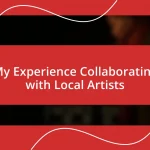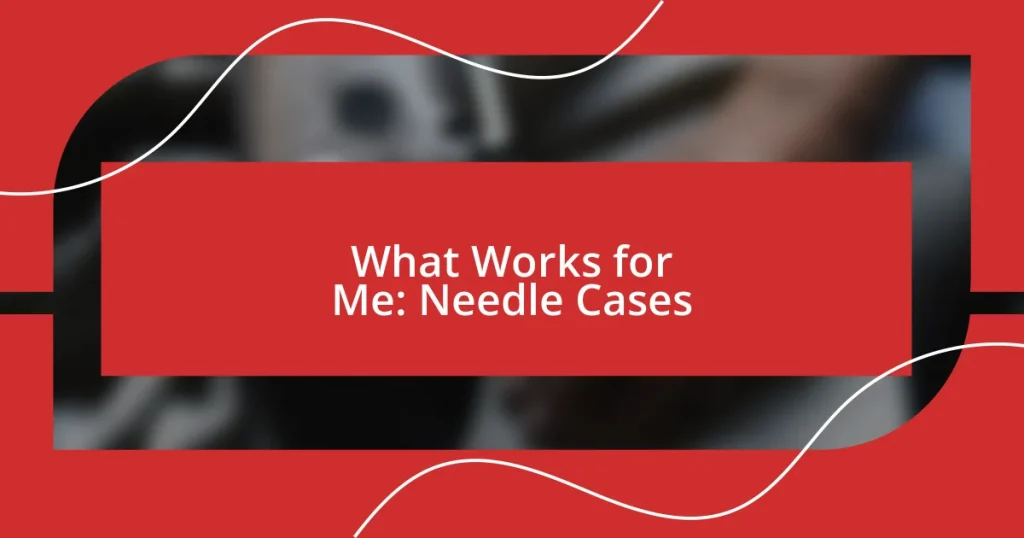Key takeaways:
- Effective collaboration thrives on open communication, active listening, and shared values, leading to innovative solutions and stronger bonds.
- Embracing diverse skills and flexible approaches can transform initial confusion into harmonious creativity, enhancing project outcomes.
- Regular reflection and clearly defined roles post-project foster growth and clarity, improving future collaborative efforts.

Introduction to Collaborative Projects
Collaborative projects take teamwork to a whole new level, blending diverse perspectives that can transform a simple idea into something extraordinary. I remember my first experience working on a textile initiative where each person brought their unique style and cultural background into the design process. It felt like creating a vibrant tapestry, each thread representing a story, a vision, or a dream.
As I delved deeper into these projects, I often pondered: what makes collaboration truly effective? From my observations, successful partnerships stem from open communication and a willingness to listen. I’ve found that when team members feel heard, the creative energy flows effortlessly, leading to innovative solutions that one person alone might not have envisioned.
While the road of collaboration isn’t always smooth, the challenges often lead to the most rewarding results. I distinctly recall a time when our group faced a significant setback, but instead of losing hope, we rallied together. That moment of unity was not just about fixing a problem; it was a testament to the power of collaboration, turning adversity into an opportunity for growth and connection.

My Journey in Textile Collaboration
My journey in textile collaboration has been a blend of excitement and growth. One memorable project involved working with artisans from different regions, each contributing their techniques and stories. I vividly recall a late-night brainstorming session where we laughed, debated, and ultimately decided on a design reflecting our shared experiences. That moment was electric—it reminded me just how powerful collaboration could be.
- Collaborating with diverse cultures enhances creativity.
- Listening actively fosters an open environment.
- Shared challenges often unveil hidden strengths.
- Celebrating small wins fuels collective motivation.
- Trust builds a foundation for innovative risk-taking.
Throughout these experiences, I discovered that each collaboration deepened my appreciation for the art of textile creation. One particular instance stands out: during a local exhibition, the undeniable joy reflected in my teammates’ eyes as we showcased our work was exhilarating. It felt less like individual pieces and more like a unified masterpiece, echoing the essence of teamwork.

Choosing the Right Partners
When you’re embarking on a collaborative textile project, one of the first steps is identifying potential partners. From my own experiences, I’ve come to realize that selecting the right individuals or groups can significantly influence the project’s outcome. For instance, I once worked with a pair of artists who had incredibly different approaches to textile design. Instead of clashing, their contrasting styles led to a unique fusion that surprised us all and expanded our creative horizons.
Communication is another essential factor when considering partners. Reflecting on a project where we had to bridge cultural gaps, I found that establishing a common language—both literal and metaphorically—was key. Open dialogue not only clarified our intentions but also fostered a sense of camaraderie. The laughter and shared frustrations we experienced brought us closer, transforming our differences into strengths.
Lastly, I often evaluate potential partners based on shared values and goals. During a collaborative venture, my team and I faced a challenge that tested our commitment. By the end, we realized how aligned our visions were, which solidified our partnership further. It’s these shared beliefs that enrich the collaborative spirit, making every struggle worthwhile and every victory sweeter.
| Criteria | Importance |
|---|---|
| Diverse Skill Sets | Enhances Creativity |
| Effective Communication | Builds Trust |
| Shared Vision | Aligns Efforts |

Techniques for Effective Communication
Effective communication can make or break a collaborative textile project. I remember a time when our team hit a wall due to misinterpretations. We were all passionate about our ideas, but without regular check-ins, frustrations mounted. It was only when we started scheduling quick catch-ups that clarity emerged. Those sessions transformed our dynamic, fostering open dialogue that made everyone feel heard. Isn’t it fascinating how just a few conversations can shift the project’s trajectory?
Listening actively is another technique that proves invaluable. I recall participating in an intense brainstorming session where one quiet member finally voiced her idea. It was a game-changer! By genuinely paying attention to all voices in the room, we unearthed unexpected gems that added depth to our designs. How often do we overlook the quieter members of a team? Investing time to ensure everyone is included not only strengthens bonds but enhances overall creativity.
Moreover, celebrating small wins can create a ripple effect of motivation. During one project, we commemorated minor milestones with simple gatherings—like sharing homemade treats or swapping texts of appreciation. These moments, though small, served as reminders of our progress and helped maintain enthusiasm. It’s amazing how the little things can create a supportive atmosphere—wouldn’t you agree that recognizing hard work lays the foundation for future success?

Managing Diverse Skills and Ideas
Managing a project with a diverse range of skills and ideas is both exhilarating and challenging. I remember a project where our team included a textile artist, a fashion designer, and a graphic illustrator. Initially, our differing expertise led to confusion, but once we embraced each other’s strengths, everything clicked into place. It’s a reminder that diversity isn’t just about the variety of skills—it’s about blending those talents to create something truly special. Have you ever experienced that moment of harmony when distinct skills come together seamlessly?
Understanding and respecting each member’s unique approach can pave the way for innovation. I once found myself working alongside a craftsman who utilized traditional dyeing techniques, while my inclination leant toward modern patterns. At first, I struggled to see how our styles could align, but as I began to appreciate his meticulous craftsmanship, I started to think outside the box. The end result was a stunning collection that neither of us could have achieved alone. It’s remarkable how shifting your perspective can invite collaboration, isn’t it?
When managing diverse skills and ideas, I’ve also learned the importance of flexibility. In one of my projects, we faced unexpected challenges that forced us to change our original plan. Instead of clinging to our initial ideas, we adapted and combined elements from each person’s expertise. This adaptive mindset not only saved the project but also enhanced its overall impact. Have you noticed how a collective willingness to pivot can breathe new life into creative endeavors?

Showcasing Our Collective Creations
Showcasing our collective creations is a moment filled with pride and excitement. I vividly remember the first time we laid out a finished project for a community exhibit. Seeing our unique pieces together, interwoven with the stories of each contributor, was electrifying. It’s incredible how a single display can capture the essence of teamwork and creativity, don’t you think?
Reflecting on our showings, I often find that sharing the process behind our creations is just as valuable as the final product itself. During one exhibition, we set up a corner where visitors could engage with us, asking questions about our techniques and inspirations. The conversations we had were heartfelt, and I could see how our passion resonated with the audience. Isn’t it rewarding when you can connect with others over the work you’ve poured your heart into?
Sharing our creations isn’t solely about showcasing the physical pieces; it’s about celebrating the journey we took together. I recall an inspiring moment when a young girl reached out after seeing our project. She said the colors and patterns inspired her to create her own art. It was a poignant reminder that collaborative efforts can ignite creativity in others. Don’t you love how your work can ripple out into the world, sparking new ideas and dreams?

Lessons Learned for Future Projects
When reflecting on lessons learned for future collaborative textile projects, I find that communication is paramount. I recall a moment in one project where assumptions went unchecked, leading to a miscommunication about design elements that dampened our progress. In hindsight, regular check-ins and open conversations could have clarified our vision early on. Isn’t it interesting how sometimes the simplest solutions, like talking more, can avert complications?
Another significant takeaway for me was establishing clear roles from the get-go. In one instance, overlapping responsibilities blurred lines and created tension among team members. Once we outlined who was responsible for what, it not only streamlined our workflow but also fostered a sense of ownership. Have you ever experienced the relief that comes with clarity in a group setting?
Lastly, I believe the power of reflection should never be underestimated. After a project is completed, taking time to discuss what worked well and what didn’t can be incredibly enlightening. I remember gathering with my team post-project, where we shared our highs and lows candidly. That session not only strengthened our relationships but also provided insights that shaped our future projects. Isn’t it amazing how a simple reflective practice can propel us forward in our creative journeys?















